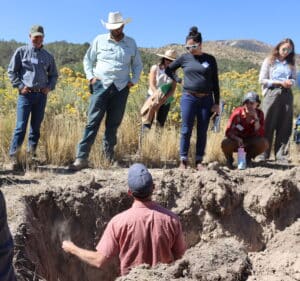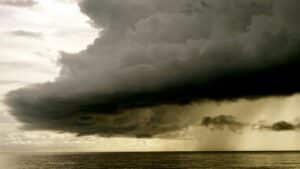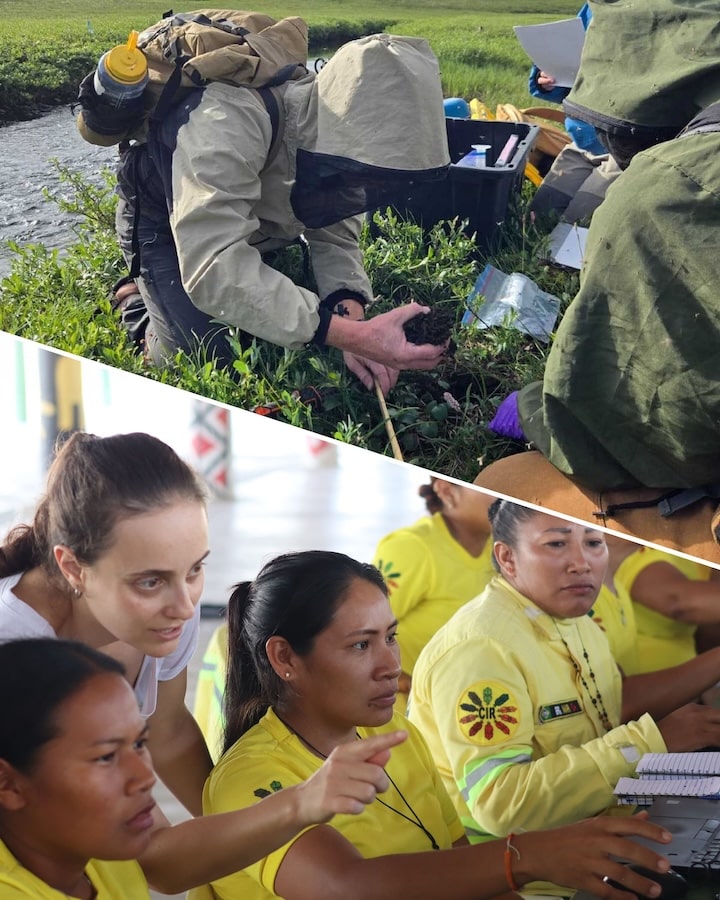How much carbon can farmers store in their soil? Nobody’s sure.
Advocates say the long-awaited farm bill could help fix that.

Dirt, it turns out, isn’t just worm poop. It’s also a humongous receptacle of carbon, some 2.5 trillion tons of it — three times more than all the carbon in the atmosphere.
That’s why if you ask a climate wonk about the U.S. farm bill — the broad, trillion-dollar spending package Congress is supposed to pass this year (after failing to do so last year) — they’ll probably tell you something about the stuff beneath your feet. The bill to fund agricultural and food programs could put a dent in the country’s greenhouse gas emissions, some environmental advocates say, if it does one thing in particular: Help farmers store carbon in their soil.
The problem is, no one really knows how much carbon farmers can store in their soil.
River,
It was when you became sick that I truly realized how much you mean to me. How long I have loved you, needed you, learned from you. My entire life I have tried to be self sufficient, but now I realize how dependent I am, and always have been, on you.
It is funny to think that I have known you my entire life. Even though I spent most of my earlier years with your cousin Big Blue, I recall seeing you from afar. You were always drifting by our house each day to visit the cranberry bogs. You ran alongside the trails that I walked with the dogs. They swam with you afterwards to cool off, but I never joined. You always seemed busy, hosting pool parties with the swans and snapping turtles. I did not think much of you then. Honestly you were a little too intimidating for my younger self.
Read more on Science on the Fly.
Six months ago, Woodwell Climate Research Center received a $5 million grant from Google.org to put advanced computing to work to track permafrost thaw in near-real time. Now, the Permafrost Discovery Gateway (PDG) project has begun convening experts in remote sensing, machine learning, process modeling, artificial intelligence, software engineering, design, and computing to build upon the existing PDG platform and create a resource hub for Arctic landscape data.
The Arctic is warming fast— up to four times faster than the global average— and as a result, the ground upon which many Northern communities are built has begun to thaw. 3.3 million Arctic residents live in settlements where models suggest permafrost could degrade and ultimately disappear by 2050, presenting an urgent need for accurate and reliable information to inform community adaptation and preparedness.
PDG was designed to use remote sensing data to identify and map permafrost-related hazards, like erosion and abrupt thaw events. Previously generated data on these features had either been coarse resolution or spanned only small areas within the Arctic. Collaborators on PDG from nine organizations improved and expanded on available data, mapping over a billion ice-wedge features across the Arctic landscape. Now, with the new Google.org funding, the team has goals to develop additional datasets, and make the resource accessible for communities.
“I feel like we have a pretty good grasp of how the PDG can help researchers working on permafrost-related topics, both in creating and in doing their science,” says Dr. Anna Liljedahl, Woodwell Associate Scientist and PDG project lead. “Now it’s time to dive deeper into the needs of the public— specifically, people living and working in the Arctic and that are dealing with ice-rich permafrost thaw hazards.”
As part of the award, Woodwell Climate also received the support of 15 Google.org Fellows— talented software engineers, user-interface designers, and product managers— most of whom are dedicated full-time to the project between January and June of 2024. The fellows’ expertise will bolster the project’s activities gathering geospatial data, refining machine learning models to detect permafrost thaw features, and designing the platform’s user interface to meet the needs of communities and decision makers.
“The Fellow support from Google.org is an award in itself,” says Dr. Liljedahl. “In addition to all the skills the Fellows bring, we’ll have a large team of people who will work full-time on just this project, which is very rare in academia. So this fellowship is a huge boost to the project, and also an opportunity for the Fellows to gain and grow from the collaboration.”
To inform this new phase of work, the PDG team hosted a workshop in November, 2023. The event convened developers of the PDG and end-users including GIS consultants, permafrost and road engineers for a conversation about what data and tools are needed to support communities affected by permafrost thaw.
The workshop highlighted basic information needs for the project— the value of detailed datasets that show the expanse of ice-rich permafrost, alongside the importance of including land ownership information and detailed descriptions of each dataset to provide a more complete understanding of the data. For Dr. Liljedahl, these insights were invaluable.
“We have mapped a billion ice-wedge polygons across the entire Arctic, but we have no map of Alaska trails, which are such an important infrastructure for Alaska’s communities as most are located off the road system. This kind of information will help us build a platform capable of serving community needs,” said Dr. Liljedahl.
Starting February 15, PDG will host a public webinar series that will continue the dialogue started in the workshop and hopefully inform not only this project, but data science research in other fields as well.
“This project addresses a need that goes beyond just permafrost— the need for accessible, public, geospatial data,” says Dr. Liljedahl. “And the need for a dedicated community to work on these difficult issues.”
What in the world is weather whiplash?

Temperatures across the United States this winter have been on a roller coaster.
Average December temperatures in Minnesota, for example, were 14 degrees Fahrenheit warmer than usual, but the following month, they plummeted below the 30-year average before swinging back up to break an all-time high on January 31, hitting a balmy 55 degrees—nine degrees above the previous daily record. Parts of Montana saw a 90 to 100-degree temperature swing in the span of a month.
Continue reading on Bulletin of the Atomic Scientists.
Woods Hole scientists named to state, federal climate advisories

Two Woods Hole scientists have been appointed to state and federal climate advisories. These advisories will begin meeting in February to provide science-based guidance to government decision-makers.
In December, Falmouth resident and Arctic ecologist Susan M. Natali was appointed to the new federal Advisory Council for Climate Adaptation Science by Secretary of the Interior Debra A. Haaland. Dr. Natali works at the Woodwell Climate Research Center, where she leads a project called Permafrost Pathways that addresses the impacts of permafrost thaw in the Arctic.
Sarah B. Das is a glaciologist and climate scientist at the Woods Hole Oceanographic Institution, where she has worked for over 20 years. She studies polar ice sheets in Greenland and Antarctica, which have been rapidly melting over the last several years. In January, Dr. Das was appointed to the Massachusetts Office of Climate Science’s new Climate Science Advisory Panel.
As part of a new partnership between Permafrost Pathways and the International Centre for Reindeer Husbandry (ICR), the Arctic Initiative at Harvard Kennedy School (Arctic Initiative) and Woodwell Climate Research Center (Woodwell Climate) hosted 18 Indigenous youth from across the circumpolar North for a day of science, mapping, storytelling, and policy programming. Woodwell Climate Senior Scientist and Permafrost Pathways Lead Dr. Sue Natali signed a formal Memorandum of Understanding (MOU) with ICR Executive Director Anders Oskal and Woodwell Climate President Dr. Max Holmes establishing a new relationship focused on climate change and Arctic resilience.
Read more on Permafrost Pathways.
Why have our winters gotten so weird?
Yes, it’s freezing now. But winters are actually warming dangerously fast.

Bitter cold continues to grip the United States as unusual freezing temperatures stretch as far south as Florida this week. Even more chilly weather is in store through the weekend, putting more than 80 percent of the US population under some type of cold weather advisory.
But this jarring cold snap is sandwiched between the end of what was the hottest year on record and the start of another year that could be even hotter. And even as temperatures plunge to new depths, the recent weather isn’t remotely enough to derail an ominous trend.
As the climate changes, the bottom of the temperature scale is rising faster than the top. This pronounced winter warming is often less palpable than the triple-digit summer heat waves that have become all the more frequent across much of the country, but no less profound.
Winter storm barrage likely to continue

Climatologists say the prevalence of strong southerly storms that have battered the Vineyard’s south shore this winter are due, in part, to the first El Niño winter in five years. Strengthened by rising and warming waters, Islanders should also expect more of these kinds of storms this season and into the future, according to experts.
Though the Vineyard and the rest of New England typically sees northeasters in the colder months, three storms have come up from the south and pass to the Island’s west, causing severe erosion at several of the Vineyard’s prized beaches.
Read more on The Vineyard Gazette.




